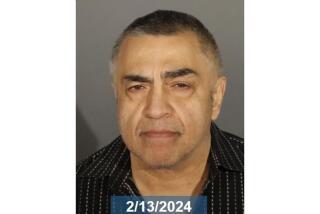Rockefeller impostor convicted of murder
The mystery behind the body buried in a San Marino backyard, defense attorneys argued, came down to this: The victimâs wife did it.
Linda Sohus had vanished in February 1985 around the same time as her husband, John. She was frustrated living with a mother-in-law who was controlling and drank too much. Two months after she disappeared, several postcards written by Linda were sent to loved ones from France.
Lawyers for Christian Karl Gerhartsreiter acknowledged that their client was a notorious con man who once masqueraded as a member of the Rockefeller family, but said that he was not a killer.
For jurors, that story â like so many involving Gerhartsreiter â unraveled under scrutiny.
After more than three weeks in trial, it took a day for the downtown Los Angeles jury to convict Gerhartsreiter of first-degree murder on Wednesday, capping a nearly three-decade-old whodunit and ending the strange odyssey of a man who went from teenage German immigrant to member of the New England social elite to now-convicted killer.
Several jurors said they quickly dismissed any notion that Linda murdered her husband, believing that Gerhartsreiter was also responsible for her disappearance.
âThat was crazy,â said Gema Vasquez, a 38-year-old nurse. âThey need to let her rest. We donât know where sheâs at. We donât know where he put her. We donât know what he did to her.â
Juror Salvador Ruiz, a retired truck driver from Norwalk, cited the lack of evidence suggesting that Linda was still alive. Authorities found no trace of her despite checking databases containing 30 billion records for some sign that she had opened a bank account, obtained a phone, used a utility, started a business, received mail or been involved in a host of other activities that would create a paper trail.
âWe couldnât get her to disappear like that,â Ruiz said.
Gerhartsreiter, 52, was accused of bludgeoning John Sohus, his landladyâs 27-year-old son, with a blunt object. The body was buried behind a guest house where Gerhartsreiter had been living on the Lorain Road property, where the couple lived with Johnâs mother in the main house.
More than 40 witnesses testified, with many recounting stories about Gerhartsreiterâs audacious frauds.
In San Marino, he introduced himself as British aristocrat Christopher Chichester. In Connecticut, he pretended to be television and film producer Christopher Crowe before persuading some on Wall Street that he was a bond trader.
But it was his act as Clark Rockefeller, an eccentric but brilliant member of Americaâs famous wealthy family, that won him entry to exclusive social clubs and fooled many, including his Harvard-educated wife.
While enjoying the high life, Gerhartsreiter remained a suspect in the disappearance of the Sohuses. The case took a macabre turn in 1994, when Johnâs remains were discovered by a construction crew building a swimming pool for the new owner of the Lorain Road property. But homicide detectives were unable to find the elusive German immigrant, who had arrived in the country as a 17-year-old.
It took more than a decade before investigators caught up with Gerhartsreiter when he made news by kidnapping his 7-year-old daughter in 2008 during an ugly custody dispute with his ex-wife. He was eventually extradited to California to face trial for murder.
âSometimes, youâre afraid that this guy has conned so many people for so many years that this will be the one last time that he pulls off his last con,â Deputy Dist. Atty. Habib Balian, who prosecuted the case, said. âBut that didnât happen and the system worked.â
In court Wednesday, the victimâs half sister dabbed her eyes with a tissue after the verdict was read.
âItâs finally over,â Ellen Sohus said.
Sohus, who described her late half brother as gentle, fun-loving and âthe original nerdâ who loved gadgets and electronics, said he âwould be so overwhelmed by how many people loved him and how many people were fighting for him.â
Defense attorney Brad Bailey said his client had been hopeful of an acquittal moments before the verdict but remained optimistic that the conviction would be overturned on appeal.
âHeâs disappointed and continues to maintain his innocence,â Bailey said. âTomorrow is a new day and new chapter in this case.â
In building a case against Gerhartsreiter, the prosecution had to overcome an array of obstacles. There was no DNA, fingerprints or other forensic evidence identifying the killer. Most of the victimâs remains were destroyed in 1995. Witnesses had trouble remembering dates that were nearly 30 years old. The new lead sheriffâs detective had to deal with incomplete reports and missing evidence from previous investigators.
Balianâs case revolved around circumstantial evidence pointing to Gerhartsreiter.
The key prosecution evidence was two plastic bags from the early 1980s that were found wrapped around the victimâs skull. One was from the bookstore at USC, where Gerhartsreiter attended film classes at the time. The other was from the bookstore at the University of Wisconsin-Milwaukee, where Gerhartsreiter was enrolled from spring 1980 to spring 1981.
The prosecutor argued that Gerhartsreiter slipped up by taking the coupleâs new truck with him when he left San Marino. In 1988, he gave the Sohusesâ truck to a friend who tried to obtain its title from California, alerting police that Gerhartsreiter and the missing coupleâs vehicle were in Connecticut.
Although Gerhartsreiter had lied about his identity before, he went to more extraordinary lengths to hide who he really was after the killing, particularly when a detective began seeking him in connection with the missing couple, Balian argued.
Witnesses testified that Gerhartsreiter changed his address, dyed his hair and used post office boxes rather than have mail sent to his home.
He used his wifeâs bank and credit card accounts, kept property in her name and avoided having formal identification, witnesses said.
Balian suggested that Gerhartsreiter either forced or conned Linda into writing the postcards to friends and family, and then had someone he knew mail them from France.
Juror Vincent Garcia, a UPS truck driver, said that the prosecutor built a convincing case and that most of the deliberations involved deciding whether Gerhartsreiter was guilty of first- or second-degree murder. He noted that there was evidence that the victim had been stabbed as well as hit at least three times over the head with a blunt object. He said a lack of motive was not a concern.
âYou donât really need a motive if the evidence is there,â he said.
Balian on Wednesday declined to discuss a possible motive in the case.
He said that there was no one piece of crucial evidence but that each piece helped build a picture that showed Gerhartsreiter was responsible.
âThe picture that was made was extremely clear,â he said.
More to Read
Sign up for Essential California
The most important California stories and recommendations in your inbox every morning.
You may occasionally receive promotional content from the Los Angeles Times.












